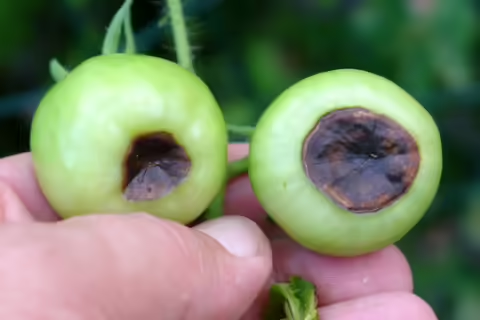URBANA, Ill. — Blossom end rot is the scourge for any tomato grower. What starts as a light tan spot at the end of the fruit where the blossom was, will expand and eventually turn black and leathery.
“When it comes to tomatoes, it is most commonly seen on larger fruited cultivars or long-fruited varieties like Roma,” says Ken Johnson, University of Illinois Extension horticulture educator. “Blossom end rot can also affect peppers, eggplants, squash, and watermelons.”
Contrary to popular belief, blossom end rot is not caused by a disease or insects. It is actually a physiological disorder caused by low levels of calcium. There are few reasons a plant may not be getting enough calcium. Usually, it’s not an issue of a lack of calcium in the soil, but rather how well the plants absorb calcium.
“Plant leaves transpire and naturally lose water so they then take up more water along with nutrients from the soil,” Johnson says. “Anything that gets in the way of transpiration can reduce calcium uptake.”
Drought stress, inconsistent soil moisture, cold or waterlogged soils, and rapid vegetative growth due to too much nitrogen fertilization can all lead to blossom end rot. High concentrations of ammonium, potassium, and magnesium in the soil, often due to over-fertilization, can also cause issues with calcium uptake.
“Others argue that blossom end rot is caused by abiotic stress to the plants,” says Johnson. Drought, high light intensity, or heat cause cells in the fruits to die which results in blossom end rot.
Regardless of what exactly causes blossom end rot, there are steps gardeners can take to prevent it.
Start by picking tomato varieties that are less prone to developing blossom end rot, such as Celebrity, Mountain Pride, and cherry tomatoes. Do a soil test to find out the calcium levels and if calcium should be added.
Avoid excessive fertilization of plants during early fruiting, especially with fertilizers using ammonium as their nitrogen source (ammonium competes with calcium uptake).
Water plants deeply starting when fruits first form and continuing throughout the growing season. In general, plants need about one inch of moisture per week, whether from rain or irrigation. If hot, dry weather is predicted, make sure plants are well watered before it arrives and continue watering daily. Adding a top layer of mulch can help conserve and even out the moisture in the soil.
Containers dry out quickly, so these plants are more likely to develop blossom end rot without consistent watering. Potted plants should be fertilized. Some soilless potting mixes have low nutrient levels, so it may be necessary to add fertilizer.
Unfortunately, once a fruit has blossom end rot, there is nothing you can do. Foliar applications of calcium don’t help much because the calcium doesn’t move into the fruit well. It is best to remove the fruit and discard it.
SOURCE: Ken Johnson, Horticulture Educator, Illinois Extension
ABOUT EXTENSION: Illinois Extension leads public outreach for University of Illinois by translating research into action plans that allow Illinois families, businesses, and community leaders to solve problems, make informed decisions, and adapt to changes and opportunities.
PHOTO ACCESS: The photo in this article is available to download for media use.
